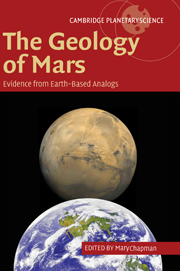Book contents
- Frontmatter
- Contents
- Preface: the rationale for planetary analog studies
- List of contributors
- 1 The geology of Mars: new insights and outstanding questions
- 2 Impact structures on Earth and Mars
- 3 Terrestrial analogs to the calderas of the Tharsis volcanoes on Mars
- 4 Volcanic features of New Mexico analogous to volcanic features on Mars
- 5 Comparison of flood lavas on Earth and Mars
- 6 Rootless volcanic cones in Iceland and on Mars
- 7 Mars interior layered deposits and terrestrial sub-ice volcanoes compared: observations and interpretations of similar geomorphic characteristics
- 8 Lava—sediment interactions on Mars: evidence and consequences
- 9 Eolian dunes and deposits in the western United States as analogs to wind-related features on Mars
- 10 Debris flows in Greenland and on Mars
- 11 Siberian rivers and Martian outflow channels: an analogy
- 12 Formation of valleys and cataclysmic flood channels on Earth and Mars
- 13 Playa environments on Earth: possible analogs for Mars
- 14 Signatures of habitats and life in Earth's high-altitude lakes: clues to Noachian aqueous environments on Mars
- 15 The Canyonlands model for planetary grabens: revised physical basis and implications
- 16 Geochemical analogs and Martian meteorites
- 17 Integrated analog mission design for planetary exploration with humans and robots
- Index
- Plate section
- References
9 - Eolian dunes and deposits in the western United States as analogs to wind-related features on Mars
Published online by Cambridge University Press: 18 September 2009
- Frontmatter
- Contents
- Preface: the rationale for planetary analog studies
- List of contributors
- 1 The geology of Mars: new insights and outstanding questions
- 2 Impact structures on Earth and Mars
- 3 Terrestrial analogs to the calderas of the Tharsis volcanoes on Mars
- 4 Volcanic features of New Mexico analogous to volcanic features on Mars
- 5 Comparison of flood lavas on Earth and Mars
- 6 Rootless volcanic cones in Iceland and on Mars
- 7 Mars interior layered deposits and terrestrial sub-ice volcanoes compared: observations and interpretations of similar geomorphic characteristics
- 8 Lava—sediment interactions on Mars: evidence and consequences
- 9 Eolian dunes and deposits in the western United States as analogs to wind-related features on Mars
- 10 Debris flows in Greenland and on Mars
- 11 Siberian rivers and Martian outflow channels: an analogy
- 12 Formation of valleys and cataclysmic flood channels on Earth and Mars
- 13 Playa environments on Earth: possible analogs for Mars
- 14 Signatures of habitats and life in Earth's high-altitude lakes: clues to Noachian aqueous environments on Mars
- 15 The Canyonlands model for planetary grabens: revised physical basis and implications
- 16 Geochemical analogs and Martian meteorites
- 17 Integrated analog mission design for planetary exploration with humans and robots
- Index
- Plate section
- References
Summary
Introduction
Eolian processes produce distinctive features and deposits on planetary surfaces where the atmosphere is sufficiently dense to allow interactions between the wind and sediments on the surface (Greeley and Iversen, 1985). Arid and semi-arid regions on Earth contain abundant evidence of wind–surface interactions (e.g., Lancaster, 1995a; Thomas, 1997), and the Martian surface shows a diverse array of eolian features across the planet (e.g., Greeley et al., 1992). The characteristics of several eolian localities (primarily sand dunes) in the western part of the United States have been used previously as analogs to features seen on Mars in data obtained from several spacecraft (e.g., Greeley et al., 1978; Greeley and Iversen, 1987; Golombek et al., 1995), yet the analog potential of other western eolian sites is relatively underutilized. Rather than attempting a comprehensive survey of all eolian features in the United States, this chapter will focus on several examples illustrative of a variety of dune forms and their potential applicability as analogs to eolian features observed on Mars. Dunes in the Great Plains, east of the Rocky Mountains, and all coastal dunes are excluded from this survey in order to concentrate on discrete sand accumulations in arid or semi-arid environments. Both traditional publications and selected internet sites (cited here as W#) are referenced throughout the text.
Eolian features in the western United States reflect varying climatic and drainage conditions that have directly contributed to the formation of the individual deposits.
- Type
- Chapter
- Information
- The Geology of MarsEvidence from Earth-Based Analogs, pp. 232 - 264Publisher: Cambridge University PressPrint publication year: 2007
References
- 5
- Cited by



